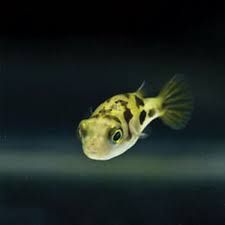Dwarf Freshwater Pea Puffer
Dwarf Freshwater Pea Puffers are one of the most unique and rewarding nano fish to keep in your aquarium. While they are small and reach a max of an inch in size, they have a striking pattern and coloration that will draw instant attention. They have black patterns on a yellowish gold body that contrasts great against a variety of plants and substrates.
Dwarf Pea Puffers can be very aggressive toward each other so lots of plants or hiding places are recommended to prevent aggression. Groups of 3 or less are ideal for a 10 gallon but they can be kept by themselves with no problem. It is often recommended to not keep them in a community setting due to the chance of them nipping the other tank-mates. We do not recommend keeping them with any type of shrimp.
Dwarf Freshwater Pea Puffer
Carinotetraodon Travancoricus, also known as the dwarf pea puffer, is a dwarf fish species known for having a striking pattern and coloration that will draw instant attention. These small fish are appreciated by hobbyists for their unique look and personality. They are the perfect addition to a planted tank or a tank with other small fish, however, we do not recommend keeping them with shrimp.
Dwarf Pea Puffer Behavior
Dwarf pea puffers are very territorial and become aggressive, especially with limited hiding spots. However, they are typically safe to keep with most small fish and other dwarf pea puffers in smaller numbers.
Dwarf pea puffers exhibit a fascinating personality and are an excellent addition to planted tanks or small community tanks, plus as an added bonus they will eat small pest snails!
Dwarf Pea Puffer Care
A carnivorous diet is ideal for the dwarf pea puffer. They often will not eat dry foods, but frozen foods such as bloodworms will be eaten successfully. As stated above, the dwarf pea puffers will also happily snack on small pest bladder snails, or any other small snails in the tank. Find out more about Dwarf Pea Puffer in The Shrimp Farm University.
Buying Dwarf Pea Puffers
Dwarf Pea Puffers are an excellent addition to any planted tank since they do not eat live plants or disturb your substrate. They will liven up your tank with their facinating personality and add some unique coloration with their striking patterns.
Scientific Name: Carinotetraodon Travancoricus
Common Name: Dwarf Pea Puffer
Other Common Name: Freshwater Dwarf Pea Puffer
Temperament: Full of personality, intelligent, sometimes aggressive
Diet: Carnivorous. Often will not eat dry foods, but frozen foods such as bloodworms are OK. They will also eat small pest snails.
Breeding: Moderate
Care Level: Moderate
Origin: India
Found in Wild: Yes
Life Span: 2-4 years
Full Grown Size: Approx. 1 inch (2.5 cm)
Approximate Purchase Size: 1/2 - 1 inch (1.25 - 2.5 cm)
General Water Parameters:
pH Range: 6.2 - 8.0, Ideal pH: 7.2
Temperature Range: 65 - 80, Ideal Temperature: 73
GH Range: 63 - 15 dkh Ideal Hardness: 8 dkh
KH Range: .3-7 dkh Ideal Hardness 4 dkh
TDS Range: 150-300
Minimum Tank Size: 10 Gallon
How big do Dwarf Pea Puffers get?
At a maximum size of around 1 inch, Dwarf Pea Puffers stay quite small.
How many Dwarf Pea Puffers can I keep per gallon?
Groups of 3 Dwarf Pea Puffers or less is ideal for a 10-gallon, but they can be kept by themselves with no problem. We recommend these small numbers because this fish can be very territorial and sometimes aggressive to other fish, including other Dwarf Pea Pufffers.
How long do Dwarf Pea Puffers live?
2-4 years is the average lifespan of a Dwarf Pea Puffer.
Are Dwarf Pea Puffers easy to Breed?
Breeding Dwarf Pea Puffers is moderately easy. Often times, if a male and female Dwarf Pea Puffer are in the same tank, the male will chase the female around for a while until they go into hiding to fertilize the eggs. Once the eggs have been fertilized, you will need to remove the adult Dwarf Pea Puffers to another tank to prevent them from eating the fry.
What is the diet of Dwarf Pea Puffers?
Dwarf Pea Puffers will thrive and remain very colorful on a varied diet of mostly carnivorous foods. Dwarf Pea Puffers will often not eat dry foods, but frozen foods such as bloodworms will be accepted. One benefit of having Dwarf Pea Puffers is that one of their favorite snacks is eating small snails, including small pest snails that are often found in planted aquariums.
What are the best tankmates for Dwarf Pea Puffers?
Dwarf Pea Puffers, in general, are pretty territorial and do not always get along with other fish. We definitely DO NOT recommend putting them in the same tank as shrimp. We recommend keeping Dwarf Pea Puffers in smaller numbers of 3 or less because they are known to thrive when in small groups due to their territorial nature.
Feel free to add small snails to the tank for them to snack on. Most other fish (other than Betas) are safe to keep with Dwarf Pea Puffers, but watch closely for aggression at first. They also LOVE planted tanks due to extra nutrients and hiding places.
What is the best way to Acclimate my new Dwarf Pea Puffer?
When adding new tankmates to your already existing tank, it is important to take the proper steps in introducing and acclimating them into their new home. The whole process is extremely stressful for the fish. Acclimation is important for fish as it allows them time to adjust to the temperature and parameters of their new environment. By doing this correctly, you will reduce the chances of shock or death of your new crayfish. We recommend drip acclimation for fish as it is generally the best option to adjust them slowly to your tank. You can find our Premium Drip Acclimation Kit here.
Is your question not listed above?
If you don't see the answer to your question, give us a quick email, and we will get back to you asap.



 Shrimp
Shrimp Fish
Fish Crab &
Crab & Plants
Plants Foods
Foods Snails
Snails




